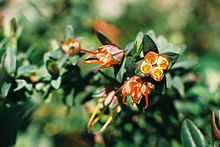Darwinia citriodora
From Wikipedia, the free encyclopedia
| Lemon-scented Darwinia | |
|---|---|
 | |
| Plate 2 from A Sketch of the Vegetation of the Swan River Colony; Hedaroma latifolium (now D. citriodora) is on the right. | |
| Scientific classification | |
| Kingdom: | Plantae |
| (unranked): | Angiosperms |
| (unranked): | Eudicots |
| (unranked): | Rosids |
| Order: | Myrtales |
| Family: | Myrtaceae |
| Genus: | Darwinia |
| Species: | D. citriodora |
| Binomial name | |
| Darwinia citriodora (Endl.) Benth. | |
Darwinia citriodora, commonly known as Lemon-scented Darwinia, is a shrub which has both erect and prostrate, forms and is endemic to Southwest Australia. It usually grows to between 0.2 and 1.5 metres in height, occasionally reaching 3 metres, and produces red, yellow, and green flowers between May and December. It occurs on granite formations and lateritic soils.
The species has been used as rootstock in attempts to cultivate species of Verticordia.
References
- "Darwinia citriodora". FloraBase. Department of Environment and Conservation, Government of Western Australia.
- Max Hewett (December 1995). "Verticordia in the Garden". Australian Plants online - June 2003. Association of Societies for Growing Australian Plants. Retrieved 2008-01-06. "Experiments carried out by Doug McKenzie indicate that Darwinia citriodora and Geraldton Wax, Chamelaucium uncinatum, are reliable stocks."
External links
- ANBG staff (2006-10-11). "Darwinia citriodora". Growing Native Plants. Australian National Botanic Gardens. Retrieved 2008-01-06.

Darwinia citriodora
This article is issued from Wikipedia. The text is available under the Creative Commons Attribution/Share Alike; additional terms may apply for the media files.